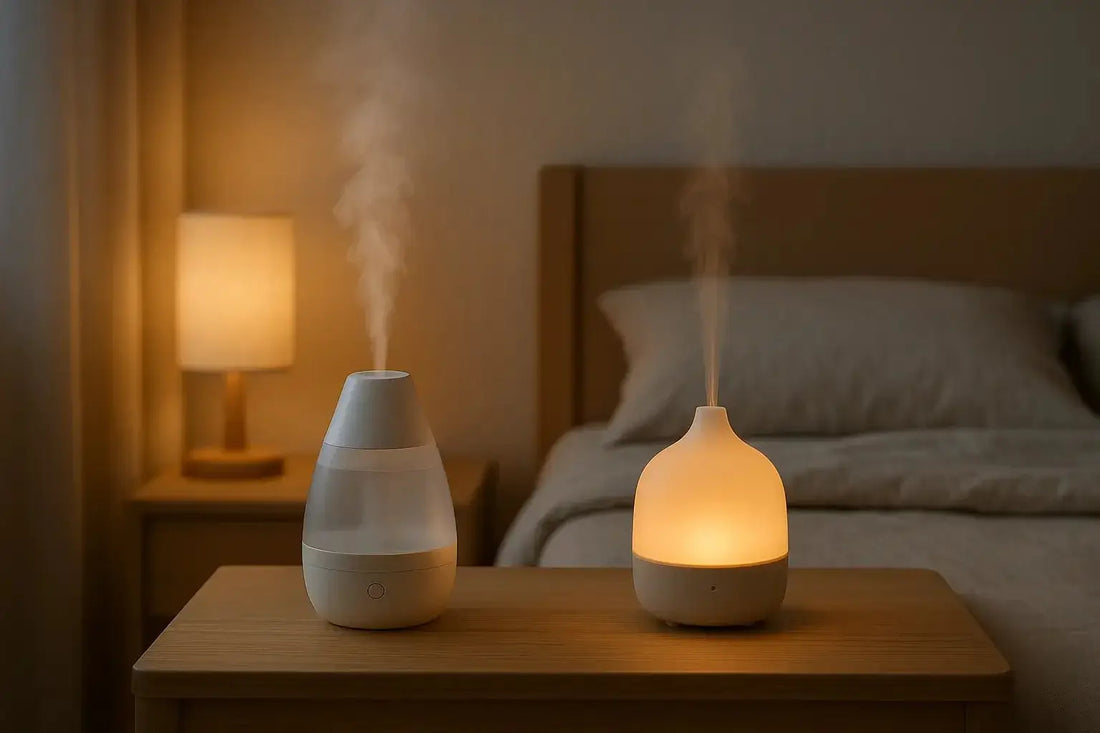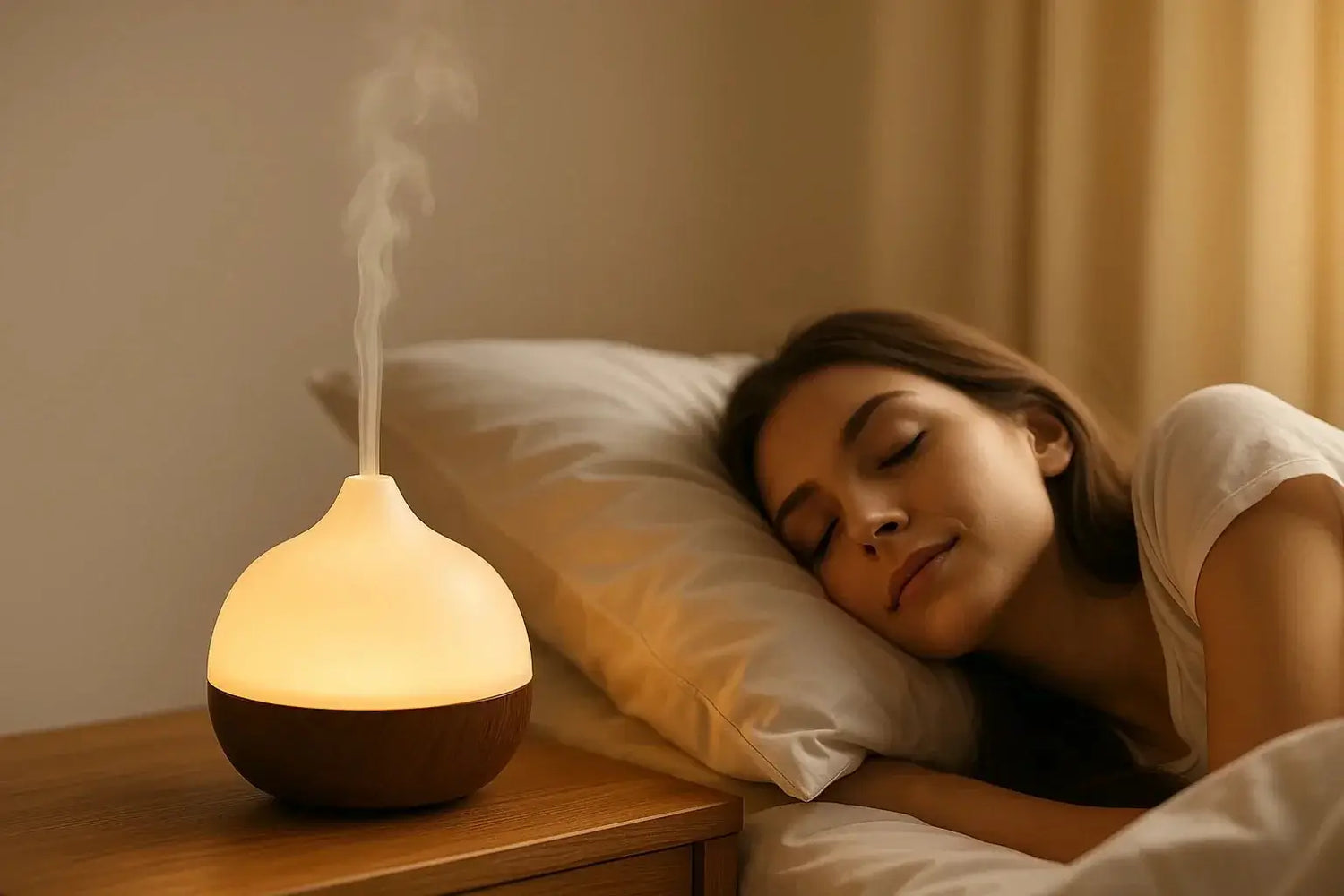
Humidifier vs Diffuser: Which Smart Sleep Device Do You Need?
Share
Looking for the right smart sleep device to calm your nights? Humidifiers and diffusers can both help you unwind—but they do different jobs. This guide explains the differences, when to use each, and how to set them up safely so you fall asleep faster and wake up refreshed.
Quick take
- Choose a humidifier if your air feels dry (itchy throat, stuffy nose, winter heat, AC). It adds invisible moisture—no scent required.
- Choose a diffuser if you want gentle aromatherapy with a light mist and cozy glow to signal “wind-down time.”
- Many sleepers use both: a quiet humidifier nightly, and a diffuser for 60–120 minutes before bed.
Humidifier vs Diffuser (side-by-side)
| Feature | Humidifier | Diffuser |
|---|---|---|
| Purpose | Adds moisture to dry air | Disperses essential oil aroma |
| Benefits for sleep | Easier breathing, less dryness & scratchy throat | Relaxing scent cues & softer ambience |
| Water + oils? | Usually no oils (unless the model has an oil tray) | Yes—2–4 drops in the tank per session |
| Coverage | Whole room | Bedside / small room |
| Runtime | All night on low | 1–2 hours before bed (timer/auto-off) |
| Best for | Dry climates, winter heat, AC, congestion | Wind-down ritual, cozy scent, gentle light |
When a humidifier is the smarter pick
If your bedroom air is dry, a humidifier is the more effective smart sleep device. It keeps humidity in a comfortable range (about 40–50%), which helps your nose and throat stay happy and reduces the “dry-air cough.” A quiet, cool-mist unit is best for sleep.
- Set up: Place on a raised surface, 1–2 m from the bed. Use clean water. Aim the mist away from walls and electronics.
- Runtime: Low or auto mode overnight. Empty and air-dry the tank daily.
- Cleaning: Rinse every day; deeper clean weekly to avoid mineral build-up.
When a diffuser is the smarter pick
If you want scent-driven relaxation, go diffuser. A few drops of lavender, chamomile, or cedarwood can make your room feel calmer. Many diffusers add a warm night light and soft fan noise—perfect cues for winding down.
- Set up: Fill to the max line, add 2–4 drops of oil, tap once for steady mist. Start 30–60 minutes before bed.
- Safety: Look for auto-off when water is low. If anyone in the room has scent sensitivities, go shorter sessions or skip oils.
- Cleaning: Rinse after use; wipe the ultrasonic plate weekly.
Can you use both?
Yes. Many sleepers pair a humidifier overnight with a diffuser pre-bed: humidity for comfort, aromatherapy for calm. Keep devices a short distance apart and avoid over-saturating the air.
How to choose the right device for you
- Check your air: Dry nose or throat? Go humidifier first.
- Consider your routine: Want a relaxing pre-sleep ritual? Add a diffuser.
- Room size: Small room or bedside table → diffuser. Larger or very dry rooms → humidifier.
- Noise & light: Pick models labeled “quiet” with warm/amber lighting or light-off options.
Shop our picks
- Deep-Sleep Diffuser (Smart Sleep Device) — gentle mist, cozy light, auto-off.
- See all Smart Sleep Devices — diffusers, humidifiers, and amber lights.
FAQs
Is a humidifier or diffuser better for sleep?
They solve different problems. Humidifiers fix dry air; diffusers add calming scent. If air feels dry, start with a humidifier. If you want a wind-down ritual, start with a diffuser—many people keep both.
Can I put oils in my humidifier?
Only if your model specifically supports oils (via a tray). Otherwise, oils can damage plastics—use a diffuser for aromatherapy.
What oils are most popular for sleep?
Lavender, chamomile, and cedarwood are common. Start with 2 drops and adjust to comfort.
Where should I place the device?
On a stable surface, about chest height and 1–2 m from the bed. Aim mist away from your face and electronics.
Bottom line: If dryness keeps you up, choose a humidifier. If you need a calming ritual, choose a diffuser. Want both comfort and calm? Use both—then drift off naturally.
Further reading
- Sleep Foundation — Benefits of a Humidifier While Sleeping
- HoMedics — Humidifier vs. Diffuser: What’s the Difference?
- Sleep Foundation — Technology in the Bedroom (why a calm, low-tech room helps)
- Forbes — Essential Oils: A Practical Guide to Safe Use
- The Sleep Store — Comparing Vaporizers, Humidifiers & Diffusers





